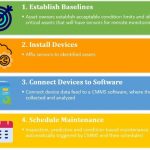
The biggest change in asset management practices and maintenance models in the coming years will be the shift from corrective and preventive to predictive and condition-based maintenance that is built on real-time as well as historical data.
With emerging new technologies like IoT (Internet of Things) and easy access to the Internet and cloud storage capabilities, accessibility to information and remote monitoring of assets can be done anytime and from any location and device. This calls for a reliable remote monitoring setup accompanied by a robust and proven management system to track and manage all that data. And it is this combination precisely that can elevate your business to a world-class maintenance program.
Why invest in remote asset monitoring?
Depending on the criticality of equipment, some need near real-time condition monitoring to ensure it is operating within expected parameters, or risk it failing with no detection capability causing significant production losses.
Remote asset monitoring enables optimized system performance and improved system reliability through continuous performance monitoring, information retrieval, and evaluation of system performance parameters. If there are on-going system anomalies or adverse conditions, remote diagnostics will identify them and equipment owners and operators will be notified through remote alarms, notifications, or annunciations.
Coupled with automated incident reporting, remote asset monitoring capabilities result in reduced maintenance cost, enhanced production quality, improved maintenance planning, increased uptime and subsequently a stronger business bottom line. Plant Capacity is best ensured and low maintenance costs maintained through continuous remote-asset monitoring.
A recent study conducted by MarketsandMarkets has identified that the market for remote asset management is expected to grow from US$16.5 billion in 2020 to US$32.6 billion by 2025.
 The major contributing factors driving the remote asset management market include the widespread adoption of IoT-enabled remote asset management solutions for increased asset efficiency, the decreasing cost of the IoT-based sensors for asset life cycle optimization life cycle and cost control, and the use of predictive and condition-based maintenance model to drive equipment reliability.
The major contributing factors driving the remote asset management market include the widespread adoption of IoT-enabled remote asset management solutions for increased asset efficiency, the decreasing cost of the IoT-based sensors for asset life cycle optimization life cycle and cost control, and the use of predictive and condition-based maintenance model to drive equipment reliability.
Advantages of remote asset monitoring
While the need to fix equipment in person won’t disappear anytime soon, the need to do other tasks on-site certainly will, including a lot of pre and post-requisite of asset maintenance work, as well as condition monitoring. The strategic advantages of having remote access to critical asset and maintenance information are quite evident; some of the key advantages of remote asset monitoring are:
- Innovative and relatively low-cost sensor technology deployments.
- Accurate and centralized monitoring.
- Ability to connect subject matter experts remotely and in a sustainable way.
- Collaboration capabilities and improved team efficiency enabled by mobile technology.
- Faster response to incidents and adverse conditions, including responding to potential employee health and safety incidents.
“Intelligent” remote asset monitoring with CMMS
Critical equipment has risk profiles where the consequences of failure can be severely impactful to the business bottom line. While remote asset monitoring brings its host of advantages, it still requires intelligent data management and implementation system that is needed at this level of maintenance management.
This is where the need for a computerized maintenance management system comes in.
Data collection and remote asset monitoring combined with an intelligent CMMS system empowers asset owners to make informed data-driven decisions and enables future-oriented predictive and condition-based maintenance strategy. Prognoses and valuable insights can be created on predicted asset performance based on actual and historical condition of equipment and their components. CMMS gives you the visibility to see important downstream activities more clearly – ahead of key decision points and help identify risks. For example, it can play a significant part in inventory management by helping identify critical spares that may be bottlenecks to upcoming equipment maintenance activities.
Whether you have assets that are already sending information to the cloud or you need to adapt current systems, it should be integrated into a CMMS solution, giving you real-time feedback and the ability to automatically trigger, schedule, and assign maintenance work based on actual equipment condition. The improvement results can only be realized by the cumulative efforts of understanding your processes, deploying remote asset monitoring devices, and then managing all the data. You can then act on the information through a dedicated CMMS software, as identified by the 4-step process below.
Conclusion
Remote asset monitoring and management is the key component of a comprehensive optimization plan that includes integrating device health with the automation platform and a CMMS.
With expanded access to CMMS and asset performance management applications, asset owners will be on the path of obtaining operational visibility of assets through their lifecycle with faster ROI, increased productivity, and better operational uptime.

Leave a Reply